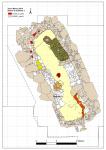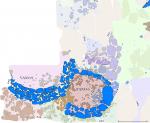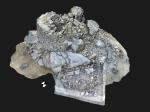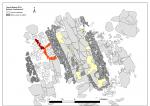Summary (English)
The 2014 campaign continued the excavations in sectors 1 and 2, which were extended, and sector 3 was opened close to the nuraghe (Fig. 1).
Sector 1, north of the nuraghe of Tanca Manna, was extended towards the south and north, reaching an overall area of 250 m2. The excavation aimed to continue the areas dug in 2013 and complete the investigation of the structures identified in 2005 so that they could then be consolidated. In particular, the investigation of room 2 was completed, identifying the entrance the north end of the west wall and completing the removal of the base levels. Two new rooms, 6 and 9 (Fig. 2), were identified in the southern extension of the excavation area. Both rooms were circular, the perimeter completed for room 6, still partial for room 9.
In Sector 2, to the south-west of the nuraghe, the excavation of rooms 3 and 4 continued. The investigation of room 3 was completed, which was of particular interest for its plan (rectangular with apse) and internal divisions using different types of walls (Fig. 3).
The excavation of room 5 (Fig. 4) was also completed, revealing the quadrangular perimeter built with a double facing of large stones and a core of smaller stones. Sector 2 was extended to the south (c. 158 m2) covering the terrace to the edge of the scarp created by quarrying in the 1960s. An occupation phases attested by the presence of numerous Bronze Age pottery fragments was identified inside this border of large stones.
Sector 3 was opened at the foot of the nuraghe, abutting the bedrock that functioned as a natural foundation for the tower (Fig. 5). The main aim was to investigate the earthwork of the nuraghe, in order to define the monument’s construction phases. Another aim was to check for the presence of dwellings similar to those in the settlement sector west of the nuraghe. To date a wall abutting the base of the nuraghe and extending to the south has been uncovered.
About 13,000 finds were processed, of which only about 500 were diagnostic (pottery, obsidian, smoothed lithic industry).
Among the finds, the largest category was impasto pottery, the commonest form being the cooking dish, with both low and medium height walls and flat base. Carenated bowls and jars with enlarged triangular-sectioned rims were also well-represented. The early middle Bronze Age dating was also confirmed by the presence of vessels with an internal flange.
Director
- Maurizio Cattani - Università di Bologna
Team
- Andrea Fiorini - Università di Bologna, Dipartimento di Archeologia
- Demis Murgia - Università di Bologna
- Florencia Debandi - Università di Bologna
Research Body
- Università di Bologna
Funding Body
- Comune di Nuoro





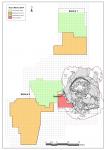
![Download [PDF]](/excavation/skins/fasti/images/results/download_sml.png)
